
Our most dependable fruit plants
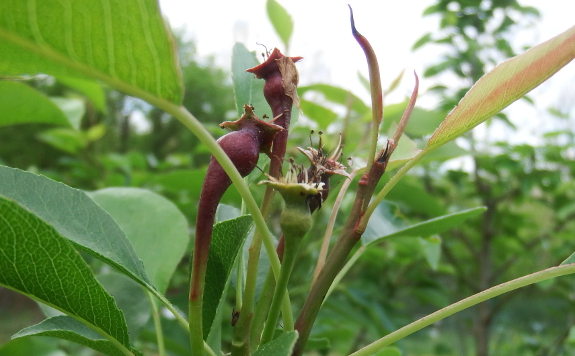
It's that time of year
again --- fruit-dreaming season! This year, the crop I'm watching most
closely is my seckel pear, which does appear to have set around half a
dozen fruits.
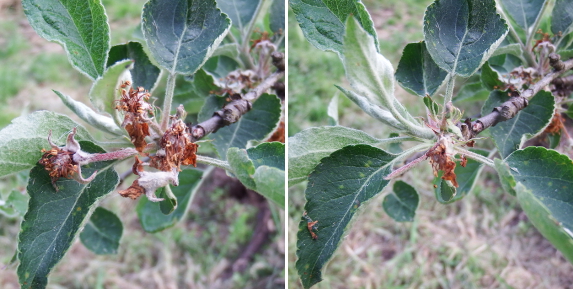
Of course, lots can
happen between now and fruit-ripening season, but
spring freeze damage and the plants' ability to hold onto the developing
ovaries are usually the deciding factors in whether or not we'll get to
enjoy a given fruit each year. For example, our apples are right at the
stage where failed flowers fall off at the lightest brush of a finger.
The photos above show the same twig before and after my test touch ---
there might be one apple staying in that cluster...if I'm lucky.
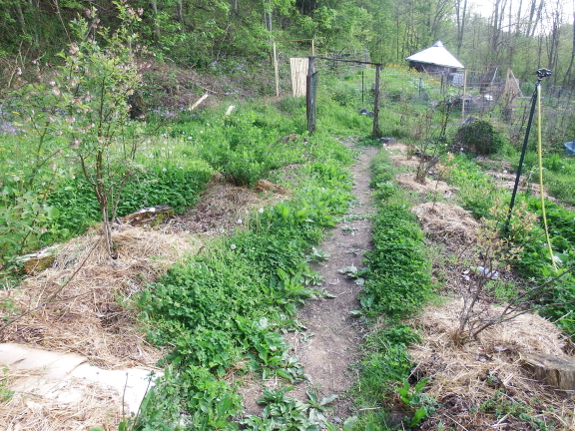
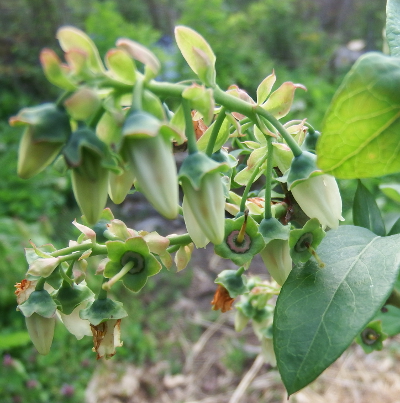 Up in the blueberry patch, there's yet more bad winter-kill news. None of the rabbiteye blueberries
outright perished in last winter's cold, but all were damaged. On the
other hand, our two northern highbush blueberries are a year or two
slower to fruit, but they shrugged off the extreme cold and are now
coated with flowers. I guess I'll be digging up the rabbiteyes and
giving them to my mom (who lives in town, at least one zone warmer),
then focusing on northern highbush blueberries in the future.
Up in the blueberry patch, there's yet more bad winter-kill news. None of the rabbiteye blueberries
outright perished in last winter's cold, but all were damaged. On the
other hand, our two northern highbush blueberries are a year or two
slower to fruit, but they shrugged off the extreme cold and are now
coated with flowers. I guess I'll be digging up the rabbiteyes and
giving them to my mom (who lives in town, at least one zone warmer),
then focusing on northern highbush blueberries in the future.
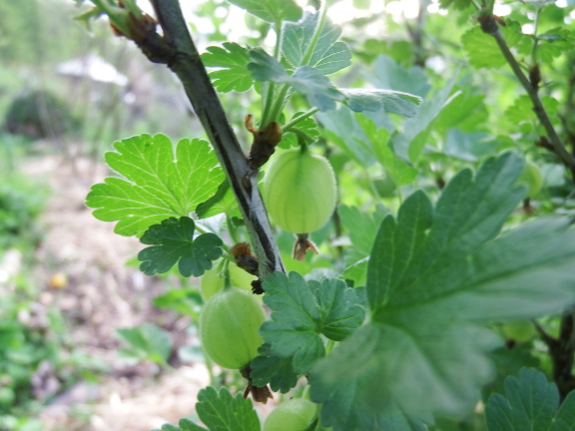
Next door, gooseberries
and currants continue to prove themselves as ultra-dependable berries.
Last summer, something defoliated our gooseberries long before their
time...but despite the damage, the bushes are loaded with fruits once
again. Winter cold, spring snaps, and apparently whatever ate their
leaves aren't nearly enough to faze this thorny but productive bush.
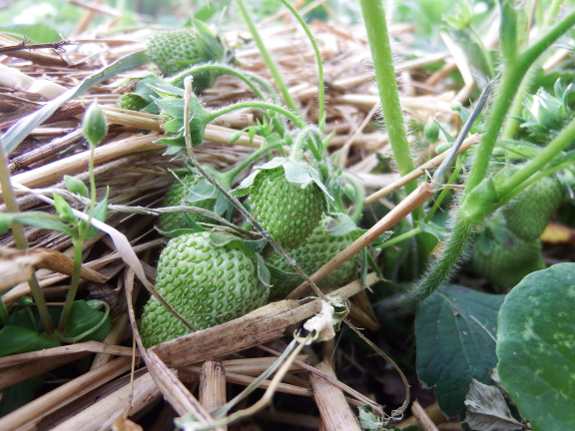
Speaking of
ultra-dependable, our strawberry fruits are plumping up as always.
Whenever I wonder why everyone doesn't focus on strawberries as one of
their primary fruits, I remind myself of the hard work that goes into
weeding out runners to ensure my plants stay big and the fruits taste
delicious. But if you're willing to weed, it's hard to go wrong with
this fast, productive fruit.
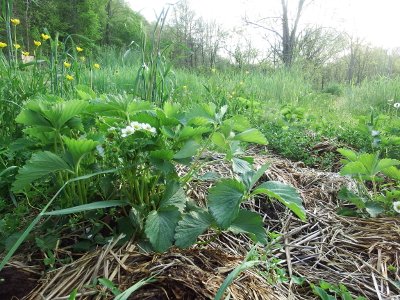 In other strawberry news, now's a good time to report on my oat-mulch experiment.
As I suspected, oats seeded around strawberry plants in the fall
competed with the main crop, resulting in much smaller plants with many
fewer flowers in the spring. The plant on the left was in the control
half of the bed, mulched with straw, and the little plant on the right
further back was surrounded by a living oat mulch. I had
to try the technique after reading about it...but I'm glad I only
experimented on a very small scale. I estimate production under the
living-mulch system will be a third to a fourth of that under my usual
system.
In other strawberry news, now's a good time to report on my oat-mulch experiment.
As I suspected, oats seeded around strawberry plants in the fall
competed with the main crop, resulting in much smaller plants with many
fewer flowers in the spring. The plant on the left was in the control
half of the bed, mulched with straw, and the little plant on the right
further back was surrounded by a living oat mulch. I had
to try the technique after reading about it...but I'm glad I only
experimented on a very small scale. I estimate production under the
living-mulch system will be a third to a fourth of that under my usual
system.
Returning to the point of
this post.... In the end, it feels a bit strange to be focusing so hard
on fewer species --- apples, pears, raspberries, strawberries, northern
highbush blueberries, 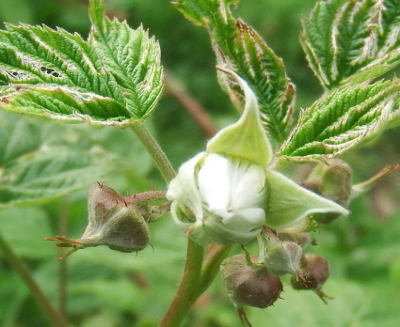 and
gooseberries --- with so many experimental species being ripped out
this spring. (Hardy kiwis, figs, and grapes are still borderline enough
to stay...for now.) On the other hand, I learned from each "failed"
species, and I'm now realizing that keeping only the dependable
producers will mean nearly as much fruit with only half the work.
and
gooseberries --- with so many experimental species being ripped out
this spring. (Hardy kiwis, figs, and grapes are still borderline enough
to stay...for now.) On the other hand, I learned from each "failed"
species, and I'm now realizing that keeping only the dependable
producers will mean nearly as much fruit with only half the work.
Mark and I envision a farm where we grow all of our food in half or a
quarter of the current time in just a few years, and I can definitely
see our garden working toward that point as we expand the top producers
and cull the duds. Of course, I'll probably spend any time saved on
further experiments. But what can you do? I like to try new things....
Want more in-depth information? Browse through our books.
Or explore more posts by date or by subject.
About us: Anna Hess and Mark Hamilton spent over a decade living self-sufficiently in the mountains of Virginia before moving north to start over from scratch in the foothills of Ohio. They've experimented with permaculture, no-till gardening, trailersteading, home-based microbusinesses and much more, writing about their adventures in both blogs and books.
Want to be notified when new comments are posted on this page? Click on the RSS button after you add a comment to subscribe to the comment feed, or simply check the box beside "email replies to me" while writing your comment.

Hi Anna and Mark,
What's happening with the hardy kiwis? With great hope, we've just bought some of these plants (zone 6b). What have been your problems? Anything you can tell us based on your experience that might help us? Thanks.
John --- Glad I could help!
Carole --- Hardy kiwis are great...except that they leaf out too early every year and then die back during Dogwood Winter, which largely prevents them from blooming. Of course, they leaf out again later, but the plants have already spent a lot of energy on the double-leafing, and thus don't seem to have energy left to fruit (although I live in hope....).
I've since read that Issai might leaf out late enough to avoid spring freezes. A friend gave me a rooted cutting a couple of years ago which might be proving that fact...or might have been winterkilled. I'm still waiting to see if it survived last winter's deep freeze.
If I had to do it over again, I'd find some way to prevent the hardy kiwis from leafing out so early. Maybe if they were on the north side of the trailer, the shade might slow them down? Or maybe if I trained them along the side of a building, I could drop an insulative layer over top of them before freezes? Not sure....